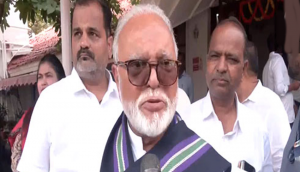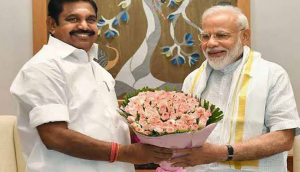Two CMs, two about-turns: What made KCR and Naidu flip-flop on note ban

Prime Minister Narendra Modi's demonetisation drive has quickly changed the political equations in the country.
In fact, in the now bifurcated Telugu-speaking states of India, Andhra Pradesh and Telangana, the Chief Ministers have made 180-degree turns on their respective points of view on demonetisation.
Modi's trusted friend in the National Democratic Alliance (NDA), Andhra Pradesh Chief Minister N Chandrababu Naidu of the Telugu Desam Party (TDP), has turned skeptical, if not critical of the Centre's move.
On the other hand, Telangana Chief Minister and TRS supremo K Chandrasekhar Rao, who has a blow-hot-blow-cold political equation with the BJP - owing to the compulsive local dynamics and a bosom friendship with BJP's bete noire and right-wing Muslim party, All-India Majlis-e-Ittehaadul Muslimeen (AIMIM) - has begun singing paeans to the note ban.
Opposing stances
The TDP has for long been demanding a withdrawal of high denomination currency. In fact, the party had talked about it on many a forum before and after the 2014 elections too.
The agenda was, of course, obvious and clear. It's more parochially political than precisely economic.
Nonetheless, the Centre dragged its feet on the issue, till Modi dropped the bombshell on TV at 8 pm on 8 November.
The rank and file of the TDP went gaga and gloated about the move. However, the ground realities witnessed over the last month and a half have muted the TDP's ranting.
On the other hand, KCR was actually the first politician in India to sense trouble with demonetisation; his bandwagon immediately started criticising it. He called on Governor ESL Narasimhan within the first three days of the PM's announcement, and expressed his dismay over the coming inconvenience and the cascading backlash.
He was right in his assessment. He brainstormed with his team of officials and came up with a concept paper and the touchpoints of the ominous proposition very quickly.
Though he did not go full throttle against the move or haul the Union government over the coals for such a 'drastic and hasty' move, he let his ire and apprehensions vent through the media in the form of 'strategic' leaks. But, KCR made sure that his party leadership didn't lose face on this sensitive issue by taking an extreme stance.
He met Modi on 20 November on the PM's special invitation, and had a lengthy discussion that softened his stand. He began slowly changing the narrative in favour of the Union government, and pledged 'conditional', yet 'wholehearted', support to the demonetisation move on the floor of the state Assembly on 16 December.
KCR, who had initially cried hoarse and expected a huge deficit in revenue receipts to the state exchequer because of demonetisation, said: "The state receipts too have been affected slightly. We should not oppose any move for the heck of it. The spirit behind the move is to achieve a noble objective. Let us all support the Prime Minister Modi. If it fails, I will myself bring a movement bigger than the Telangana movement."
Reasons for KCR's volte face
KCR's about-turn apparently has five solid reasons behind it:
- He was the first and only Chief Minister to have been invited by Modi to discuss the issue and iron out any differences. Gripped by a sudden sense of elusive importance, KCR wanted to lend his shoulder to bear Modi's palanquin.
- Expecting financial and other favours to the new state, KCR eschewed his anti-demonetisation stand and embraced a pro-Modi stand. It paid off as Telangana (Rs 20,704 crore) elbowed out Andhra Pradesh (Rs 14,740 crore) in terms of receiving new currency replenishment.
- KCR is someone who ensures he never closes all the doors. He works overtime to locate an escape route from politically embarrassing situations. In this case, he could always say mitigating people's suffering will get greater preference to policy decisions like demonetisation, and create a narrative and discourse to buttress his argument.
- KCR always gets a kick out of gaining a strategic upper hand over Chandrababu Naidu. The PM's invite put him ahead of his 'colonial cousin', leaving Naidu sulking, even after being made chairman of the Chief Ministers' committee to enforce cashless transactions.
- Last, but not the least, KCR sees a consolidated BJP as his main Opposition, rather than the Congress. By hook or by crook, KCR has annulled the Opposition in the state over the last two years. This pro-Modi stand would keep the BJP from taking him on, at least for some time.
Naidu's flip-flop and feeble defence
Meanwhile, the staunch votary of demonetisation, Chandrababu Naidu, made a volte-face on Tuesday, and blurted out his feelings against the move. Of course, he retracted his comments the next day, for obvious political reasons, but in a feeble manner.
"Demonetisation was not our wish but it happened. More than 40 days after demonetisation, there are still a lot of problems, yet there appears to be no solution," he said at a TDP workshop on Tuesday.
His retraction, however, was so feeble that his observations were 'misrepresented', and that it was actually a "good decision, although implementation challenges exist."
So what are the reasons for this flip-flop?
- Naidu's boys who went out onto the streets brought back negative feedback about demonetisation. The public was exasperated, and the TDP became wary of it very quickly. It first made its social media bleaters, who pose as if their views are independent of the party stand, pour scorn. Eventually, not-so-insignificant leaders were given the command from the top to spurn the decision, and take a strong position in favour of the common man standing in queues in front of banks.
- The party, which has been demanding the scrapping of Rs 500 and Rs 1000 notes for a long time, opposed the introduction of Rs 2000 note as well. It miserably failed in factoring in the backlash from the public, and utterly underestimated the negative impact it could cause, what with the myriad lacunae in its implementation.
- The TDP perceived that its perennial punching bag, YS Jaganmohan Reddy, could be cornered and asphyxiated financially with this decision. By doing this, it reduced the mega move to a micro level. Ironically, Jagan is facing charges of quid pro quo arrangement, which allegedly happened through multiple companies and all transactions were cashless.
- Naidu and the TDP are particularly sore with the fact that KCR suddenly became Modi's blue-eyed boy. Though Naidu's hurt feelings were placated by enthroning him as the chairman of the CMs' committee, it did not deliver the expected placebo effect in the strained TDP-BJP relations.
- Naidu, in fact, began to understand the ramifications and nuances of implementation only after he took over the reins of the CMs' committee. His interactions with economists made him realise that the country is now neck-deep in an economic quagmire. Wriggling the nation out of the slush isn't as easy as pushing it into the political and financial quicksand.
In this scenario, Modi may use Naidu's antipathy to his advantage and take steps to recant the decision in a phased manner, or may use KCR's eulogy to surge ahead, come what may.
Edited by Shreyas Sharma
More in Catch
Demonitisation was not our wish, there are still many problems: Chandrababu Naidu
SBI-Big Bazaar deal: How Ramdev & Chandrababu Naidu's family stand to gain
In 15 years: how KCR rose from middling leader to regional satrap
First published: 24 December 2016, 6:08 IST





![BJP's Kapil Mishra recreates Shankar Mahadevan’s ‘Breathless’ song to highlight Delhi pollution [WATCH] BJP's Kapil Mishra recreates Shankar Mahadevan’s ‘Breathless’ song to highlight Delhi pollution [WATCH]](https://images.catchnews.com/upload/2022/11/03/kapil-mishra_240884_300x172.png)

![Anupam Kher shares pictures of his toned body on 67th birthday [MUST SEE] Anupam Kher shares pictures of his toned body on 67th birthday [MUST SEE]](https://images.catchnews.com/upload/2022/03/07/Anupam_kher_231145_300x172.jpg)






